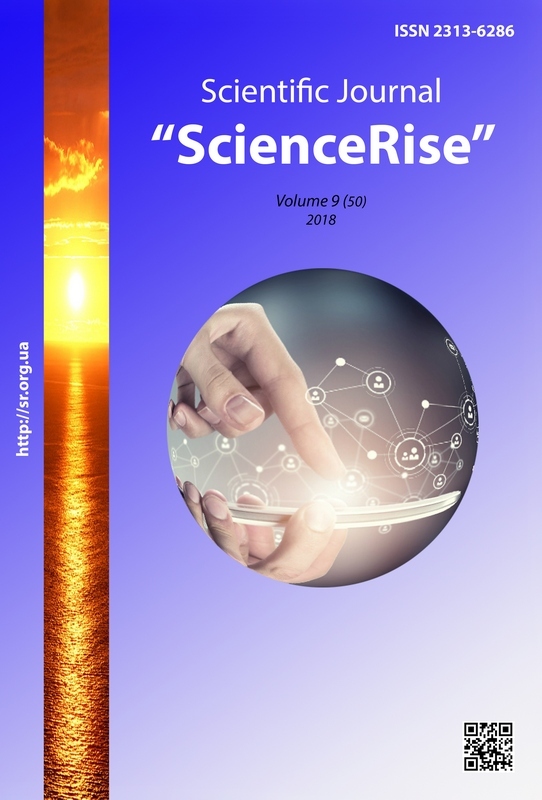Analysis of methods, models and algorithms of personalization for the recommender systems development
DOI:
https://doi.org/10.15587/2313-8416.2018.152949Keywords:
personalization, methods, models, algorithms and taxonomy of knowledge for recommender systemsAbstract
In the article the methods, models and algorithms of personalization in the digital environment are investigated. The general characteristic of types of recommender systems, their methods, models and algorithms, advantages and disadvantages of application are given. The paper proposes to use taxonomy of knowledge for creating an intelligent personalization application to support the adoption of marketing solutions for enterprises in the digital environment. Additional data sources have been allocated to create recommendations
References
Kotler, F. (1990). Osnovy Marketinga [Basics of Marketing]. Moscow: Progress, 672.
Blackwell, R., Miniard, P., Engel, J. (2007). Povedenie potrebiteley [Consumer Behavior]. Saint Petersburg: Peter, 944.
Aleshina, I. V. (2006). Povedenie potrebiteley [Customer behaviour]. Moscow: Economist, 525.
Prokopenko, O. V., Troyan, M. Yu. (2008). Povedinka spozhivachiv [Consumer Behavior]. Kyiv: Tsentr uchbovoyi literatury, 176.
Kahneman, D., Tversky, A. (1979). Prospect Theory: An Analysis of Decision under Risk. Econometrica, 47 (2), 263–292. doi: http://doi.org/10.2307/1914185
Tversky, A., Kahneman, D. (1992). Advances in prospect theory: Cumulative representation of uncertainty. Journal of Risk and Uncertainty, 5 (4), 297–323. doi: http://doi.org/10.1007/bf00122574
Zhuravleva, G. P., Manokhina, N. V., Smagina, V. V. (Eds.) (2016). Povedencheskaya ekonomika: sovremennaya paradigma ekonomicheskogo razvitiya [Behavioral economics: the modern paradigm of economic development]. Moscow-Tambov: Izdatel'skiy dom TGU im. G. R. Derzhavina, 340.
Voronkova, O. V. (2012). Povedenye spozhyvachiv [Consumer Behavior]. Tambov: Yzd-vo FHBOU VPO «THTU», 84.
Linden, G., Smith, B., York, J. (2003). Amazon.com recommendations: item-to-item collaborative filtering. IEEE Internet Computing, 7 (1), 76–80. doi: http://doi.org/10.1109/mic.2003.1167344
Amatriain, X., Basilico, J. (2012). Netflix Recommendations: Beyond the 5 stars (Part 1). Netflix Technology Blog. URL: https://medium.com/netflix-techblog/netflix-recommendations-beyond-the-5-stars-part-1-55838468f429
Corinna, U. (2018). Use Cases of Recommendation Systems in Business – Current Applications and Methods. Available at: https://emerj.com/ai-sector-overviews/use-cases-recommendation-systems/
Zlatyeva, D. (2016). Opyt personalizatsii kontenta v Le Boutique: kak intuitsiya pobezhdayet machine learning [The experience of personalizing content in Le Boutique: how intuition wins machine learning]. Available at: https://retailers.ua/news/tehnologii/5102-opyit-personalizatsii-kontenta-v-le-boutique-kak-intuitsiya-pobejdaet-machine-learning
Jones, M. T. (2014). Rekomendatel'nyye sistemy: Chast' 1. Vvedeniye v podkhody i algoritmy. Printsipy raboty rekomendatel'nykh mekhanizmov Interneta [Recommender systems, Part 1. Introduction to approaches and algorithms. How the Internet recommenders work]. IBM Corporation. Available at: https://www.ibm.com/developerworks/ru/library/os-recommender1/index.html
Tilahun, B., Awono, C., Batchakui, B. (2017). A Survey of State-of-the-art: Deep Learning Methods on Recommender System. International Journal of Computer Applications, 162 (10), 17–22. doi: http://doi.org/10.5120/ijca2017913361
Korbut, D. (2017). Recommendation System Algorithms. Main existing recommendation engines and how they work. Available at: https://statsbot.co/blog/recommendation-system-algorithms/
Chatti, M. A., Dakova, S., Thus, H., Schroeder, U. (2013). Tag-based collaborative filtering recommendation in personal learning environments. IEEE Transactions on Learning Technologies, 6 (4), 337–349. doi: http://doi.org/10.1109/tlt.2013.23
Pyatikop, E. E. (2013). Issledovaniye metoda kollaborativnoy fil'tratsii na osnove skhodstva elementov [The research of collaborative filtering method based on neighborhood elements]. Informatika, kíbernetika ta obchislyuval'na tekhníka, 109–114.
Machine Learning (8) – Recommender Engine: Collaborative Filtering (2015). Available at: oliviaklose.azurewebsites.net
Hofmann, T., Puzicha, J. (1999). Latent Class Models for Collaborative Filtering. IJCAI '99 Proceedings of the Sixteenth International Joint Conference on Artificial Intelligence. San Francisco: Morgan Kaufmann Publishers Inc., 688–693.
Langseth, H., Nielsen, T. D. (2012). A latent model for collaborative filtering. International Journal of Approximate Reasoning, 53 (4), 447–466. doi: http://doi.org/10.1016/j.ijar.2011.11.002
Shams, B., Haratizadeh, S. (2017). Graph-based collaborative ranking. Expert Systems with Applications, 67, 59–70. doi: http://doi.org/10.1016/j.eswa.2016.09.013
Swathi, S., Sreeja, D., Shelbi, J., Seetha, P. (2017). Various Methods of Using Content-Based Filtering Algorithm for Recommender Systems. International Journal of Innovative Research in Science, Engineering and Technology, 6 (2), 1606–1613.
Asanov, D. (2004). Algorithms and Methods in Recommender Systems. Berlin: Institute of Technology. Available at: https://www.snet.tu-berlin.de/fileadmin/fg220/courses/SS11/snet-project/recommender-systems_asanov.pdf
Lorenzi, F., Ricci, F. (2005). Case-based recommender systems: a unifying view. ITWP'03 Proceedings of the 2003 international conference on Intelligent Techniques for Web Personalization. Acapulco: Springer-Verlag, Berlin: Heidelberg, 89–113. doi: http://doi.org/10.1007/11577935_5
Marung, U., Theera-Umpon, N., Auephanwiriyakul, S. (2016). Top-N Recommender Systems Using Genetic Algorithm-Based Visual-Clustering Methods. MDPI Reference List and Citations Style Guide. Basel,
Feng, D. (2015). Utility-based Recommender Systems Using Implicit Utility and Genetic Algorithm. International Conference on Mechatronics, Electronic, Industrial and Control Engineering, 860–864. doi: http://doi.org/10.2991/meic-15.2015.197
Brusilovsky, P., Kobsa, A., Nejdl, W. (2007). The adaptive web: methods and strategies of web personalization. Heidelberg: Springer-Verlag Berlin, 762.
Dent, A. (2015). An In-Depth Look At Second-Party Data For Digital Marketers. Available at: https://marketingland.com/second-party-data-digital-marketers-128254
Sonntag, D. (2015). ISMAR Tutorial on Intelligent User Interfaces, Proceedings of ISMAR 2015. Related DFKI Technical Report.
Downloads
Published
Issue
Section
License
Copyright (c) 2018 Yuliia Kotliarova

This work is licensed under a Creative Commons Attribution 4.0 International License.
Our journal abides by the Creative Commons CC BY copyright rights and permissions for open access journals.
Authors, who are published in this journal, agree to the following conditions:
1. The authors reserve the right to authorship of the work and pass the first publication right of this work to the journal under the terms of a Creative Commons CC BY, which allows others to freely distribute the published research with the obligatory reference to the authors of the original work and the first publication of the work in this journal.
2. The authors have the right to conclude separate supplement agreements that relate to non-exclusive work distribution in the form in which it has been published by the journal (for example, to upload the work to the online storage of the journal or publish it as part of a monograph), provided that the reference to the first publication of the work in this journal is included.

